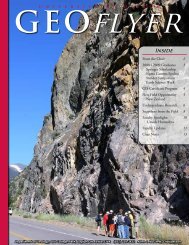Stander Symposium abstract book - University of Dayton
Stander Symposium abstract book - University of Dayton
Stander Symposium abstract book - University of Dayton
Create successful ePaper yourself
Turn your PDF publications into a flip-book with our unique Google optimized e-Paper software.
ORAL PRESENTATIONS<br />
COLLEGE OF ARTS AND SCIENCES<br />
BIOLOGY<br />
The Effects <strong>of</strong> Silver and Titanium Dioxide Nanoparticles on D. melanogaster Life History<br />
and Reversal <strong>of</strong> Effects with Vitamin C Supplementation<br />
Presenter(s): Caitlin B Cipolla-Mcculloch<br />
Advisor(s): Mark G Nielsen<br />
Biology<br />
1:00 PM-1:20 PM<br />
Honors Thesis Kennedy Union - 222<br />
Nanoparticles (NPs) are particles that have one or more dimensions onthe order <strong>of</strong> 100 nanometers or less. They are <strong>of</strong> interest becauseparticles <strong>of</strong><br />
such a small size have unique properties that differ fromtheir bulk sized counterparts, primarily due to their high surface tovolume ratio. Nanoparticles<br />
are increasingly being used formanufacturing and consumer products. As a result, the chance <strong>of</strong> humanexposure to these materials is<br />
increasing. Of particular interest inthis regard are silver and titanium dioxide NPs, used in sunscreen,cosmetics and technological manufacturing.<br />
We show that silver, butnot titanium dioxide particles are toxic to longevity, reproduction,and development. We were able to reverse these effects<br />
usingantioxidants, which supports an oxidative stress model <strong>of</strong> nanoparticletoxicity and provides a means to remediate nanoparticle toxicity.<br />
Blow Fly Oviposition Dynamics on Liver Bait and Swine Carcasses Exposed at Dusk<br />
Presenter(s): Maureen C Berg<br />
Advisor(s): Mark E Benbow<br />
Biology<br />
2:00 PM-2:20 PM<br />
Independent Research Kennedy Union - 211<br />
One aspect <strong>of</strong> forensic entomology uses insect evidence to estimate a time <strong>of</strong> death (TOD). The major assumption that blow flies do not oviposit<br />
at night can potentially <strong>of</strong>fset TOD estimates up to 12h. Previous studies have indicated either no observed nocturnal oviposition, or reduced<br />
activity associated with artificial lighting. The objectives <strong>of</strong> this study were to test for nocturnal oviposition, and to evaluate the effects <strong>of</strong> lighting<br />
conditions on oviposition, and further to monitor oviposition on replicate swine carcasses within different habitats.In the Liver Experiment, we<br />
evaluated blow fly oviposition <strong>of</strong> liver baits under three experimental light treatments in a wooded lot. We hypothesized that nocturnal oviposition<br />
would not occur, but diurnal oviposition would be correlated with environmental conditions. In summer 2009, liver bait (N=3) was placed<br />
out 2hrs prior to sunset, and oviposition was monitored for 24h (determined by NOAA). Approximately 25% <strong>of</strong> collected eggs were reared for<br />
identification. A regression analysis for Phormia regina was developed to predict the egg number from egg mass (F=1775, df=43, p

















